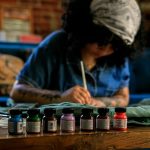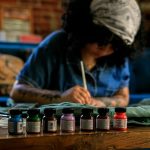To restore a faded leather sofa, start by cleaning it gently with a mild soap solution and vacuuming to remove dirt. Next, condition the leather to prevent dryness and cracking. Choose the right dye that matches your sofa’s type and apply it evenly in thin layers, allowing each to dry. Finally, seal the surface to lock in color and protect it from wear. Keep following these steps, and you’ll uncover tips to keep your sofa vibrant longer.
Table of Contents
Key Takeaways
- Clean the leather sofa gently with a vacuum and mild pH-balanced soap to remove dirt and prepare for restoration.
- Condition the leather every 3-6 months using a product suited to its type to restore suppleness and prevent cracking.
- Test and apply a matching leather dye in thin, even layers with a sponge, allowing each layer to dry fully before the next.
- Seal the recolored leather with a suitable sealant to lock in color and protect from wear and environmental damage.
- Maintain regular cleaning, conditioning, and avoid direct sunlight to prolong the sofa’s restored color and durability.
Assessing the Condition of Your Leather Sofa
Before you begin restoring your leather sofa, you need to carefully assess its condition. Start by examining the surface for cracks, tears, or deep scratches. Check if the leather feels dry or brittle, which indicates it needs conditioning.
Pay attention to discoloration patterns; uneven fading may require targeted restoration. Test a small hidden area to see how the leather reacts to light pressure—this can reveal weakening fibers.
Don’t overlook the sofa’s frame and cushions; a sagging structure can affect the overall look and comfort after restoration. Also, identify the type of leather you have—aniline, semi-aniline, or pigmented—as this influences the products you’ll use.
This thorough evaluation guarantees you choose the right methods and materials for a lasting restoration.
Cleaning the Leather Surface Properly
Although it may seem simple, cleaning your leather sofa properly is essential to guarantee the restoration products adhere well and deliver the best results.
Start by vacuuming the surface with a soft brush attachment to remove dust and debris from crevices. Next, prepare a mild cleaning solution using warm water and a few drops of gentle, pH-balanced soap.
Vacuum with a soft brush, then clean gently using warm water and mild, pH-balanced soap.
Dampen a soft cloth with this solution and gently wipe the leather, avoiding soaking it. After cleaning, use a dry microfiber cloth to remove excess moisture.
Avoid harsh chemicals or abrasive tools, as they can damage the leather’s surface. Proper cleaning assures that dirt and oils won’t interfere with the restoration process, setting a clean base for the next steps in bringing your sofa’s color back to life.
Choosing the Right Leather Conditioner and Dye
Now that your sofa is clean, it’s time to pick the right conditioner and dye to bring back its color and softness.
You’ll want to choose products that match your leather type and follow proper application techniques for the best results.
Let’s explore how to select and apply these materials effectively.
Types of Leather Conditioners
Choosing the right leather conditioner and dye can make all the difference in restoring your faded leather sofa.
When it comes to conditioners, you’ll find options like oil-based, water-based, and cream conditioners. Oil-based conditioners deeply nourish and soften leather but might darken its color, so test first. Water-based conditioners absorb quickly and won’t alter the leather’s hue, making them great for light-colored sofas. Cream conditioners provide a protective layer and help restore suppleness without heavy buildup.
Avoid using household oils or waxes—they can damage your leather over time. Always pick a conditioner compatible with your sofa’s leather type, whether it’s aniline, semi-aniline, or pigmented.
Using the right conditioner keeps your leather healthy, flexible, and ready for dyeing if needed.
Selecting Appropriate Leather Dye
Selecting the right leather dye is essential to reviving your sofa’s original color and ensuring a lasting finish. First, identify your sofa’s leather type—aniline, semi-aniline, or pigmented—as each requires specific dye formulations.
Choose a dye that matches your sofa’s original color closely; test it on a hidden area to confirm the shade and absorption. Opt for water-based dyes if you want easier application and less odor, or solvent-based dyes for deeper penetration and durability.
Avoid using fabric or acrylic paints, as they can crack or peel on leather. Additionally, pick a dye that offers UV protection to prevent future fading.
Application Techniques and Tips
Start by preparing your leather sofa with a suitable conditioner to restore moisture and flexibility before applying any dye.
Choose a conditioner designed for your leather type to prevent damage and guarantee even absorption.
After conditioning, test the dye on a hidden spot to confirm color match and compatibility.
Use a clean, soft cloth or a sponge to apply the dye in thin, even layers, working with the grain of the leather.
Allow each coat to dry completely before adding another to build up color gradually.
Avoid over-saturating the leather to prevent streaks or blotches.
Finally, seal the color with a protective finish to enhance durability.
Following these steps will help you achieve a smooth, natural-looking restoration.
Applying Leather Dye to Restore Color
Before you apply leather dye, make certain the sofa’s surface is clean and dry to guarantee even absorption.
Use a sponge or applicator pad to apply the dye in thin, even layers, working in small sections. Apply the dye with smooth, circular motions, making sure of full coverage without saturating the leather.
Allow each layer to dry completely before applying the next, usually about 20-30 minutes. Multiple thin coats build richer, more consistent color than one heavy coat.
Be sure to test the dye on a hidden area first to confirm color match and leather reaction. Avoid rushing the process; patience guarantees a natural, uniform finish.
Once you’ve achieved the desired shade, let the sofa dry thoroughly before moving on.
Sealing and Protecting the Recolored Leather
Now that you’ve restored the color, it’s essential to seal and protect the leather to keep it looking fresh.
Choose the right sealant and apply it carefully to guarantee long-lasting protection.
Plus, following some simple maintenance tips will help your sofa stay vibrant for years.
Choosing the Right Sealant
To lock in the color and keep your leather sofa looking fresh, you’ll need to pick the right sealant. Opt for a product specifically designed for leather; it should protect without altering the texture or causing buildup.
Water-based sealants are great for preserving softness and flexibility, while acrylic or polyurethane sealants offer stronger protection against spills and stains. Consider your sofa’s use—if it’s heavily used, a more durable sealant is best.
Also, check that the sealant is compatible with the dye or paint you applied. Avoid anything too glossy if you want a natural finish.
Finally, read product reviews and test the sealant on a hidden spot to verify it doesn’t discolor or harden the leather before committing to the entire sofa.
Application Techniques for Protection
Selecting the right sealant sets the stage for protecting your leather sofa’s renewed color. Before applying, make certain the sofa’s surface is clean and dry.
Use a soft, lint-free cloth or a sponge to apply the sealant evenly in thin layers. Work in small sections, rubbing gently in circular motions to guarantee full coverage without oversaturating the leather. Allow each layer to dry completely before applying the next, usually 15 to 30 minutes, depending on the product.
Applying multiple thin coats offers better protection than one heavy coat. Avoid direct sunlight or heat sources during application and drying, as they can affect adhesion.
Once sealed, your leather will resist fading, stains, and wear, keeping its vibrant look longer.
Maintenance Tips for Longevity
Although restoring your leather sofa’s color is an essential step, maintaining that restoration requires consistent care. To keep the leather looking fresh and vibrant, you need to seal and protect the recolored surface regularly. Use a high-quality leather sealant to lock in the color and shield against spills and UV damage. Avoid harsh cleaners and always test products on a small area first. Regularly condition the leather to prevent drying and cracking.
| Maintenance Task | Recommended Frequency |
|---|---|
| Apply leather sealant | Every 6 months |
| Clean with mild soap | Monthly |
| Condition leather | Every 3 months |
| Avoid direct sunlight | Always |
Following these tips will extend your sofa’s beauty and durability.
Maintaining Your Leather Sofa for Long-Lasting Color
Since regular care directly affects your sofa’s appearance, maintaining your leather sofa properly helps preserve its color and prevents further fading.
You should dust and vacuum your sofa weekly to remove dirt and debris that can dull the leather. Use a soft, damp cloth with a mild leather cleaner every few months to clean the surface gently. Avoid harsh chemicals or excessive water, which can damage the leather.
Condition the sofa every six months to keep the leather supple and vibrant, using a product suitable for your leather type. Keep your sofa away from direct sunlight and heat sources, as these accelerate fading and drying.
Frequently Asked Questions
Can I Restore Color on Synthetic Leather the Same Way?
You can’t restore synthetic leather exactly like real leather because it doesn’t absorb dyes the same way. Instead, use specialized vinyl or faux leather paint to refresh its color and protect the surface effectively.
How Long Does the Leather Dye Typically Last Before Fading Again?
You know what they say, “A stitch in time saves nine.” Leather dye typically lasts 1-3 years, but if you keep your sofa clean and conditioned, you’ll delay fading and keep that rich color longer.
Are There Specific Brands of Leather Dye Recommended for Sofas?
You’ll find brands like Fiebing’s, Angelus, and Leather Studio highly recommended for leather sofas. They offer durable, vibrant dyes that penetrate well. Choose based on your sofa’s leather type and desired finish for best results.
Can Sun Exposure Permanently Damage Leather Beyond Restoration?
Did you know over 70% of leather damage results from sun exposure? Unfortunately, yes—you can permanently damage leather beyond restoration if it’s exposed too long. So, keep your leather shaded to preserve its beauty and durability.
Is It Safe to Restore Leather Sofas With Pets or Children Around?
You should guarantee proper ventilation and use non-toxic, pet- and child-safe products when restoring leather. Keep pets and children away during the process to avoid exposure to chemicals and accidental ingestion. Safety comes first.
- Recycling Nonwoven Fabrics: Is It Possible? - July 11, 2025
- Recycling Nonwoven Fabrics: Is It Possible? - July 11, 2025
- Recycling Nonwoven Fabrics: Is It Possible? - July 11, 2025







